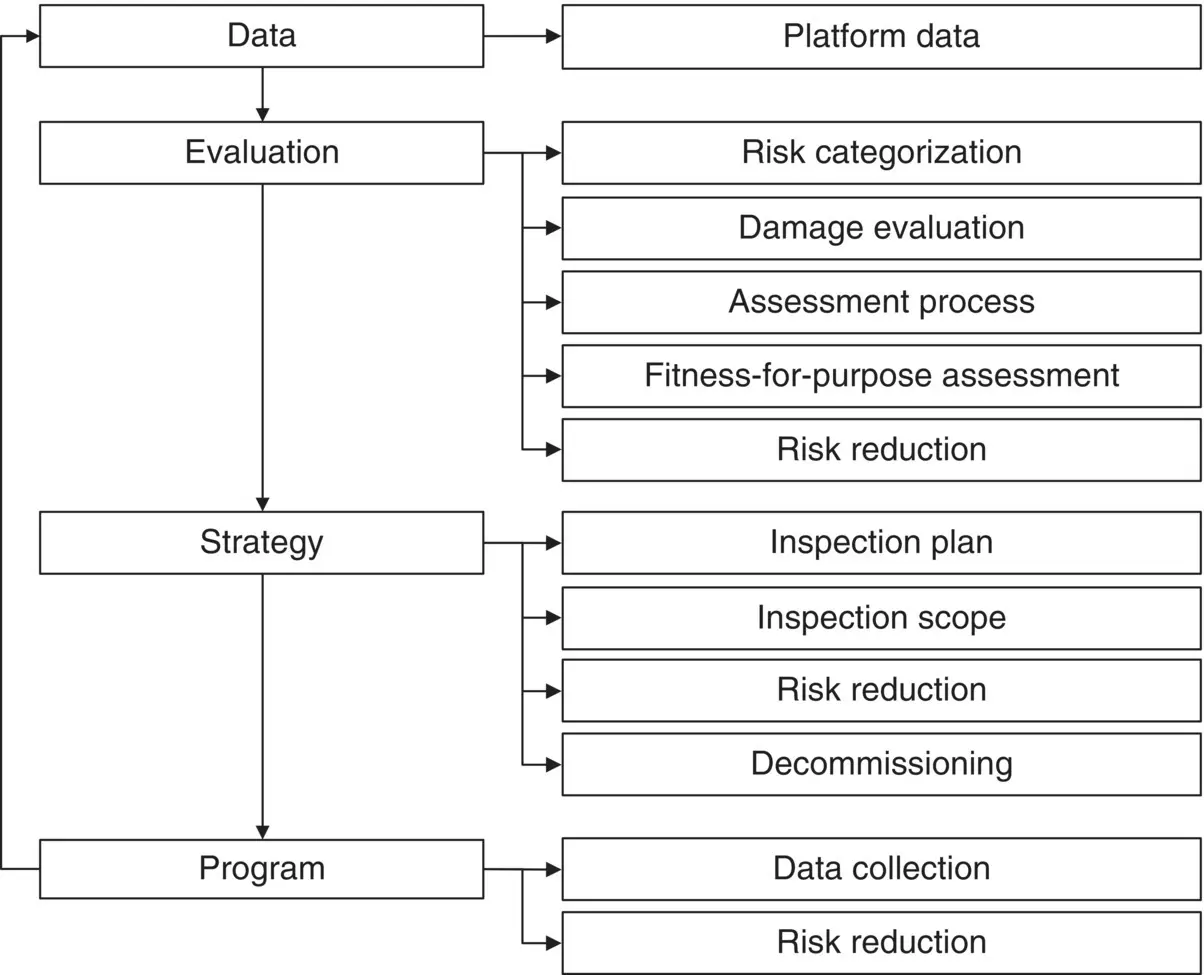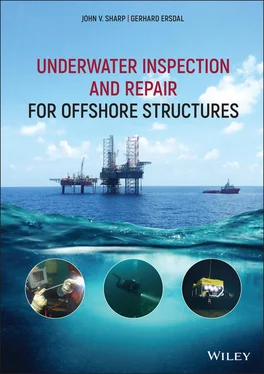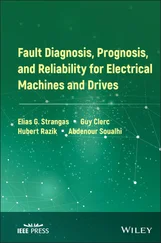1 ...8 9 10 12 13 14 ...18 The RP builds upon the required survey intervals as shown in Table 1and includes a simplified risk‐based methodology for inspection planning. Further, the RP details engineering practices for the evaluation, assessment and inspection of existing fixed offshore structures to demonstrate their fitness‐for‐purpose.
The RP describes the recommended SIM process, with details of each aspect of the process, as shown in Figure 8. As can be seen, the damage evaluation, assessment process, risk reduction (e.g. repair), the inspection plan and scope are of particular relevance to this book.

Figure 8 Main SIM process of API RP 2SIM (API 2014b) and follow‐on steps.
Source: Modified from API (2014b), API RP‐2SIM Recommended Practice for Structural Integrity Management of Fixed Offshore Structures, American Petroleum Institute, 2014.
The RP requires a baseline underwater inspection to be undertaken to determine the as‐installed platform condition. The baseline underwater inspection should include a visual survey of the platform for structural damage and the presence and condition of anodes and installed appurtenances. Further, the RP requires routine underwater inspections to be conducted to provide the information necessary to evaluate the condition of the platform and appurtenances. A plan for these routine inspections, depending on the risk evaluation, is provided in API RP‐2SIM (API 2014b) giving the intervals and scope for the inspections, the tools and techniques to be used and the methods of deployment.
A simplified risk‐based approach to inspection was introduced in API RP 2SIM (API 2014b). Intervals for level II inspection were stated depending on risk levels (manning level and likelihood of failure). The risk‐based inspection programme should also specify if level III or level IV inspections are required. Damage or deterioration found during a level II inspection may trigger a level III or level IV inspection. This risk‐based approach is used to redefine the inspection intervals as shown in Table 1, allowing for longer intervals for low likelihood of failure L‐1 platforms but also requiring shorter intervals for high likelihood of failure L‐2 platforms. The setting of inspection intervals for level II inspections greater than 10 years for L‐1 platforms requires the operator to demonstrate a number of factors, including that the platform is unmanned and that the annual level I CP readings are performed and are acceptable.
API RP‐2SIM (API 2014b) states that flooded member detection (FMD) can provide an acceptable alternative to close visual inspection of preselected areas in a level III survey. Engineering judgment should be used to determine the optimum use of FMD and close visual inspection of joints. Close visual inspection of pre‐selected locations for corrosion monitoring should be included as part of the level III survey.
Inspection tools and techniques are covered in general terms in API RP‐2SIM (API 2014b), including details of the standard methods as covered in Chapter 4 of this book. Evaluation of damaged components and repair is addressed in the recommended practice in line with Chapters 7and 8 of this book. The standard also addresses the structural assessment process, outlining a series of approaches. Four different levels of assessment are developed, which include:
simple methods, e.g. comparison with a similar platform;
design methods, e.g. linear (elastic) methods to check the platform member‐by member, similar to the approach used for the design of new platforms;
ultimate strength method, e.g. using a non‐linear or equivalent linear method to determine platform performance on a global basis;
alternative methods, e.g. using historical performance of the platform or explicit probabilities of survival of the platform for the assessment.
Personnel qualifications are listed for personnel responsible for conducting the evaluation and developing the inspection strategy, as further discussed in Section 4.4.5.
2.3.3 API RP‐2FSIM (Floating Systems Integrity Management)
API RP‐2FSIM (API 2019a) is a Recommended Practice (RP) intended to be used by owners and engineers in the development, implementation and delivery of a process to maintain system integrity of floating production systems (FPSs), which includes tension leg platforms (TLPs). The specifications, procedures and guidance provided within the RP are based on internationally recognized industry standards and on global industry best practices. This RP does not cover moorings, which are separately covered by API RP‐2MIM (API 2019b).
API RP‐2FSIM (API 2019a) states that an inspection plan should define the scope and frequency of inspection, the tools and techniques to be used and the deployment methods. This plan should be developed for the FPS structural and system components. The main objectives of the inspection plan are to identify areas of corrosion, coating deterioration, damage due to overloading, impact or abrasion, as well as areas affected by marine growth and debris. The plan should also measure or confirm the CP potentials, sensors and alarms, marine system functions and mooring equipment functions. The inspection plan should consist of a set of scheduled work scopes to be performed over the service life of the FPS. In addition, unscheduled surveys should follow an unexpected event such as exposure to a near‐level design event (e.g. hurricane).
API RP‐2FSIM (API 2019a) states that underwater surveys should be performed on the submerged areas of the hull and this should include external marine system components and the mooring system hull attachments. These surveys should also confirm that the corrosion protection system of the external hull is functioning adequately. It is recommended that external hull surveys can be performed on a continuous cycle where a specified percentage of the hull is inspected over a period and at the end of the period all of the hull is covered. A default inspection program for the hull structure is included with calendar‐based intervals and the extent of structure to be inspected by different inspection methods (GVI, CVI, ultrasonic testing and weld inspection).
Monitoring of the structure and marine systems are recommended in API RP‐2FSIM (API 2019a) in addition to inspection. Typical monitoring methods for floating structures are further discussed in Chapter 5.
API RP‐2FSIM (API 2019a) describes an assessment process and acceptance criteria, similar to other relevant API RPs, including the assessment of fatigue damage. The fatigue assessment should assess the fatigue loading behaviour and analyse the remaining fatigue life of critical locations such as welded joints and details in highly stressed areas. If the predicted fatigue life exceeds allowable levels, API RP‐2FSIM (API 2019a) states that improvement options may be considered, including local structural modifications, increased inspection frequency, change of loading conditions and using improved inspection techniques.
Methods for the repair of damage and modifications are described in API RP‐2FSIM (API 2019a), including completely renewing a locally damaged area by means of a structural repair. This may involve the addition of a new structure (e.g. stiffening to reinstate the capacity in a damaged area). Modification of the structural details may be used to minimise the potential for future damage, particularly fatigue (e.g. by grinding).
The development of the international standard ISO 19902 (ISO 2007), concerned with fixed offshore structures began in 1993, including a section on structural integrity management in the early drafts. This standard was first issued formally in 2007, but the early drafts were used as the basis for structural integrity management in the period from 1993 to 2007. In 2019 the SIM part of this standard was transferred to a new ISO standard, ISO 19901‐9 (ISO 2019a), which focused on structural integrity management and assessment of existing structures.
Читать дальше













